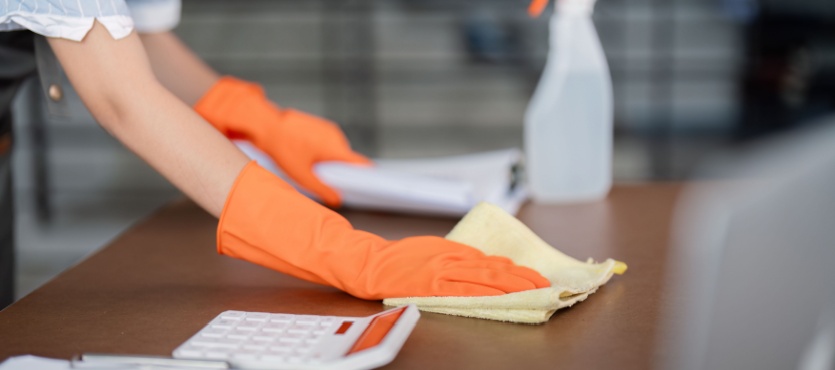In any workplace, countless surfaces are touched by multiple employees, clients, and visitors throughout the day. Door handles, keyboards, elevator buttons, phones, and shared office equipment all serve as hotspots for bacteria and viruses. Without regular sanitization, these high-touch surfaces can contribute to the rapid spread of germs, increasing the likelihood of workplace illnesses and employee absenteeism.
Maintaining a clean office environment isn’t just about aesthetics—it’s about protecting the health and productivity of everyone in the workspace. Regularly sanitizing high-touch surfaces helps reduce the spread of bacteria, promotes employee well-being, and creates a safer, more efficient work environment.
Why High-Touch Surfaces Are a Major Concern
Every time someone touches a shared surface, they leave behind bacteria, viruses, and other pathogens that can survive for hours or even days. Research shows that viruses like the flu can survive on surfaces for up to 48 hours, while bacteria such as E. coli and Staphylococcus can linger even longer.
In an office setting, employees commonly touch the same objects, making it easy for germs to transfer from one person to another. Without proper cleaning and disinfection, an illness affecting one employee can quickly spread throughout the workplace, leading to increased sick days and reduced productivity.
High-Touch Surfaces That Need Frequent Sanitization
Some of the most frequently touched surfaces in an office include:
- Door handles and push plates – Employees, clients, and visitors constantly use these, making them one of the most germ-prone surfaces.
- Keyboards and computer mice – Used daily, these surfaces accumulate bacteria, dust, and allergens.
- Phones and headsets – Shared office phones and personal desk phones are breeding grounds for bacteria.
- Desks and conference tables – Employees often eat, work, and interact at these surfaces, leading to contamination.
- Elevator buttons and light switches – High-traffic areas like elevators and shared spaces require extra attention.
- Breakroom appliances and shared kitchen surfaces – Coffee machines, microwaves, refrigerators, and countertops can harbor bacteria from frequent use.
The Benefits of Regularly Sanitizing High-Touch Surfaces
Reduces the Spread of Illnesses: One of the primary benefits of sanitizing high-touch surfaces is minimizing the spread of illnesses, such as the flu, colds, and other infectious diseases. Offices are communal spaces where employees frequently interact, making them susceptible to outbreaks. Routine sanitization significantly reduces the presence of bacteria and viruses, lowering the risk of office-wide infections and absenteeism.
Enhances Employee Productivity and Well-Being: A clean and hygienic workspace contributes to better employee health, reducing the likelihood of workers calling in sick. Fewer sick days mean greater efficiency, improved team collaboration, and uninterrupted workflow. Employees also feel more comfortable and valued when they know their workplace prioritizes cleanliness and hygiene.
Creates a Professional and Welcoming Atmosphere: Clients, business partners, and visitors judge a company by its appearance. A well-maintained, sanitized office conveys professionalism and care for both employees and guests. Clean conference rooms, sanitized reception areas, and spotless desks leave a positive impression, making clients more likely to trust and engage with your business.
Supports Compliance with Health and Safety Standards: Certain industries, such as healthcare, hospitality, and food service, have strict hygiene regulations. Even for corporate offices and retail spaces, maintaining cleanliness is essential for meeting basic health and safety standards. Businesses that fail to uphold proper sanitation practices may face complaints, decreased employee morale, and potential liability issues.
Improves Indoor Air Quality: Regular sanitization also contributes to better indoor air quality. Dust, allergens, and bacteria accumulate on high-touch surfaces, eventually circulating through the air. Proper cleaning reduces airborne pollutants, creating a healthier workspace for employees, particularly those with allergies or respiratory conditions.
Best Practices for Sanitizing High-Touch Surfaces in Offices
To effectively eliminate bacteria and viruses, use disinfectants approved by the Environmental Protection Agency (EPA). These products are specifically designed to kill harmful pathogens without damaging office surfaces.
High-touch surfaces should be sanitized multiple times a day, especially in high-traffic areas. Businesses should implement a structured cleaning schedule, ensuring that all frequently used surfaces are disinfected regularly.
While professional cleaning services play a crucial role, employees should also be encouraged to maintain personal hygiene and cleanliness at their workstations. Providing disinfectant wipes, hand sanitizers, and hygiene reminders can help reinforce good cleaning habits.
Partnering with a professional cleaning company ensures that office spaces receive thorough and consistent sanitization. Professional cleaners have the expertise, equipment, and disinfectants necessary to maintain high hygiene standards, especially in large office environments with heavy foot traffic.
Protect Your Workplace with Tidy Team Cleaning Services
Sanitizing high-touch surfaces is a simple yet effective way to reduce the spread of germs, improve employee well-being, and create a safe and welcoming work environment. Businesses that prioritize cleanliness benefit from fewer sick days, increased productivity, and a more professional atmosphere.
Tidy Team Cleaning Services specializes in thorough office cleaning, including high-touch surface sanitization, to help keep your workspace clean, safe, and productive. Contact us today to learn more about how we can support your office cleaning needs.

